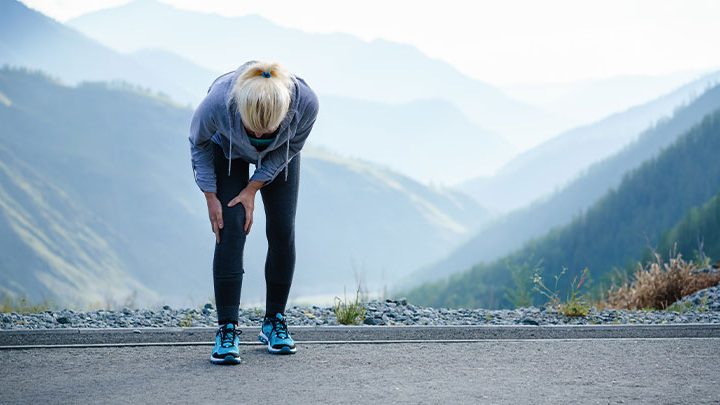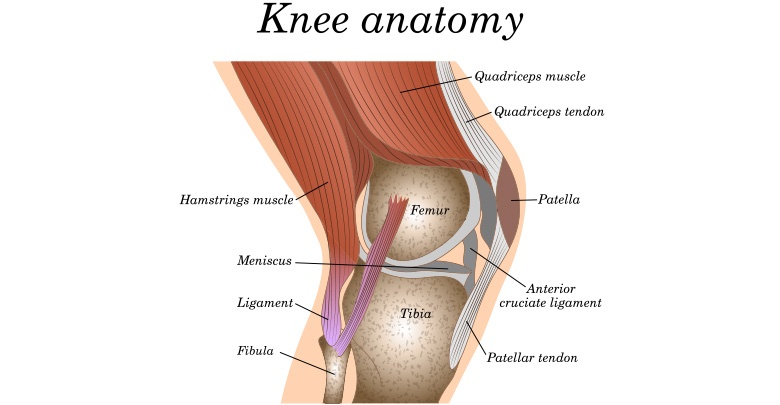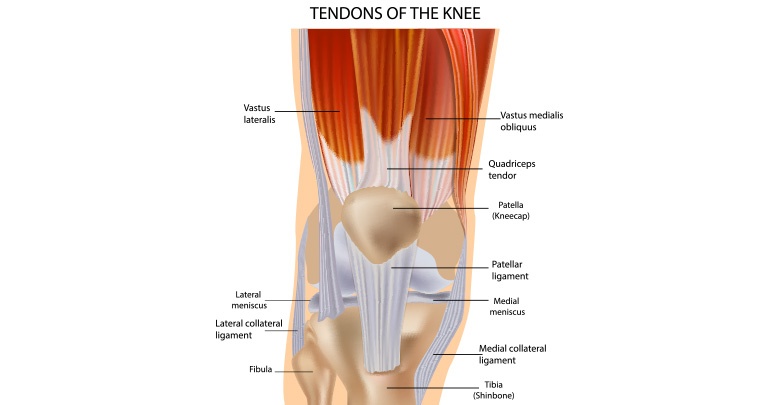Why is my Knee Swollen and Sore? The causes of knee pain
What your knee is painful or swollen, simply explained

Why your knee is painful or swollen, simply explained
There are many parts of the knee, or even conditions, which may be the cause of your knee pain and swelling. Read this article written by our in-house physiotherapist, to get a better idea of what may be causing your knee pain….
USE the OMH exclusive code "HEALTH15" to Save 15%Knee joint anatomy
Firstly you may need a basic anatomy lesson to better understand the various parts, which make up your knee joint – which is a pretty amazing hinge joint structure. You will also get a better understanding of the difference between a ligament and a tendon.

Parts of the knee
- ligaments – are tough fibrous bands which connect bones to other bones
- tendons connect muscle to bone
- joint capsule is made up of the synovium, which is a soft, supple lining of flexible tissue surrounding the entire joint
- synovial fluid is a thick liquid which lubricates and nourishes the joint cartilage.
- medial meniscus and the lateral meniscus act as shock absorbers
- quadriceps muscles which straighten your knee
- hamstrings which bend your knee
- popliteus muscle which locks and unlocks your knee from a fully straightened position
- bursas are small pouches that lie between the tissues – such as between bones and tendons, or between muscles and bones to prevent friction.
Different causes of knee pain
It is possible to sustain a specific injury to any of the above parts of your knee joint – from an accident, a fall, impact, a sudden forceful movement, whilst playing sport, or doing a simple task. Acute injuries are covered in our previous article, titled Torn Knee Ligaments.
However in this article I will explain some fairly common non-injury sources of knee pain and swelling.. (There are other much less common causes of knee pain and swelling, which are not all covered here.)
I have arranged the conditions relating to where you would feel the pain the most: the front, back, inside or outside of your knee…
Causes of pain around the knee cap

1.The patella tendon
The patella tendon may become inflamed, due to a so-called tendinopathy. Causes: typically this condition occurs due to sports involving jumping and landing. Symptoms: there is usually no swelling, no clicking or clunking, and no decrease in range of movement. Typically, squatting, or going downstairs aggravates the pain.
2. Patellofemoral syndrome
Patellofemoral syndrome causes pain in the front of the knee, around the knee cap. Causes: usually due to poor movement patterns (biomechanics) caused by muscle weaknesses and imbalances. Symptoms: there may be very slight swelling – your knee may just look a bit “puffy”. Squatting movements, sitting for long periods with your knees bent, kneeling, climbing up stairs, or running, aggravate the pain. Sometimes there may be a gritty feeling under you patella. Usually you would have normal range of movement.
3. Osteoarthritis
OA, especially when the patella is greatly affected, can present with pain at the front of the knee. Causes: age – osteoarthritis typically occurs in older people over 50, although sometimes younger if there has been a previous knee injury or you have played extreme sports. Being overweight or obese also increases your risk of developing OA Symptoms: osteoarthritis typically presents with stiffness and pain, especially following sustained joint positions or when waking up in the morning. Often the stiffness causes a decrease in range of movement, especially as the condition progresses.
4. Pre-patella bursitis
This is also called “housemaids knee”. Causes: typically this comes from spending too much time kneeling on the floor cleaning as the name suggests Symptoms: typically presents as superficial swelling over the patella (knee cap).
Causes of pain and swelling behind the knee

1. Joint effusion
Swelling associated with pain in the back of the knee may be caused by a joint effusion. Causes: any condition such as osteoarthritis, rheumatoid arthritis, a ligament tear or muscle tear, may cause this condition. Symptoms: knee joint swelling and pain at the back of your knee.
2. Synovitis
Synovitis is an inflammation of the lining of the joint. Causes: due to the inflammation of this lining, the joint produces more synovial fluid, leading to swelling. Synovitis occurs especially in patients with rheumatoid arthritis. It may also occur in osteoarthritis, gout or lupus sufferers. Symptoms: swelling, heat, redness and pain with movement, lots of night pain.
3. Baker’s Cyst
A Baker’s cyst is a chronic effusion or swelling that causes a bulge at the back of the knee. It is also called a popliteal cyst Causes: a Baker’s cyst is almost always associated with other joint problems, and so the underlying cause needs to be figured out – whether it is secondary to a meniscal injury, osteoarthritis or rheumatoid arthritis, or some other joint pathology. Symtoms: a swollen bulging feeling at the back of the knee which may limit knee bending, or feel uncomfortable with bending your knee
4. Hamstring tendinopathy
A hamstring tendinopathy would cause pain at the back of the knee, and may occur in active individuals. Causes: typically people suffering from a hamstring tendinopathy have very tight hamstrings and calf muscles, and weak glutes, leading to an overload of the tendons. Symptoms: hamstring tendinopathy would present with very little swelling, and the pain is directly related to the activity.
5. Popliteus
Poplieus is a small triangular shaped muscle behind your knee joint. This may give you pain due to a tendinopathy of the muscle, a strain or simply from trigger points within the muscle.
Not to be missed if you have pain behind the knee or back of the leg
- It is very important to note that pain at the back of your knee may be referred pain from your lower back. This referred pain would most likely be a poorly localized, dull ache, not related to knee movements, but aggravated by movements in your lower back (sometimes the pain is delayed though!) So do be aware of that possibility …
- Deep Vein Thrombosis (DVT – otherwise known as a blood clot) may occur following surgery, a period of immobilization – such as a long flight or time spent on extended bed rest, following an injury, in woman taking estrogen, or in obese patients. It may present as pain in the calf, or in the back of the knee. There may be some mild swelling, tenderness or skin discoloration. If you are worried you may have a DVT, speak to your doctor to arrange for further investigations such as a Doppler ultrasound.
Causes of pain on the inner side of the knee
1. Strain of the MCL (medial collateral ligament)
MCL sprain can result from excessive day-to-day strain on the ligament, and may also result in inflammation of the bursa too. Causes: this may be as a result of being knock-kneed, or from excessive strain due to breaststroke kicking.
2. Medial meniscus
You can sustain a gradual “wear and tear” injury to your medial meniscus Cause: previous excessive sport; being overweight or obese; previous injury to the meniscus Symptoms may present with pain on the inside of the knee, particularly with weight bearing activities and twisting/bending actions of the knee.
3. Medial compartment osteoarthritis
This simply means that the osteoarthritis is mainly affecting the inner aspect of the knee joint. Causes: age – osteoarthritis typically occurs in older people over 50, although sometimes younger if there has been a previous knee injury or you have played extreme sports. Being overweight or obese also increases your risk of developing OA Symptoms: This would typically present as pain around the inside/front of the knee, and is typically worse with sustained positions such as sitting for long periods of time, and on waking the joint feels stiff and painful.
Causes of pain on the outer side of the knee
1. Iliotibial Band Syndrome (ITBS)
ITBS is a fairly common injury in runners. The iliotibial band is a thick band of connective tissue, which runs from the top of the hip all the way down to attach on the outer aspect of the knee joint. Causes: it usually becomes painful due to poor joint biomechanics combined with repetitive loading. Symptoms: pain is typically worse with repetitive movement as in running which typically aggravates the pain on the outside of the knee.
2. Lateral meniscus
You can sustain a gradual “wear and tear” injury to your lateral meniscus Cause: being bow-legged, previous excessive sport; being overweight or obese; previous injury to the meniscus Symptoms: may present with pain on the outer side of the knee, particularly with weight bearing activities and twisting/bending actions of the knee.
3. Lateral compartment osteoarthritis
This is osteoarthritis affecting the outer aspect of the knee joint. Causes: age – osteoarthritis typically occurs in older people over 50, although sometimes younger if there has been a previous knee injury or you have played extreme sports. Being overweight or obese also increases your risk of developing OA Symptoms: this would typically present as pain around the outside of the knee, and is typically worse with sustained positions such as sitting for long periods of time, and on waking the joint feels stiff and painful.
Treatment options for knee injuries
As you can see there are many possible causes of your non-injury related knee pain and swelling! As always, we at OhMy.Health recommend that you see your trusted health care practitioner who should do a through examination of your knee joint.
These exercises for knee pain are safe to do for almost all knee conditions, but if in doubt check in with your physical therapist.
If you have any swelling in your knee joint, you should also follow the tried and trusted RICE protocol. It stands for Rest, Ice, Compression, and Elevation.

If you have been unlucky enough to sustain a knee ligament or meniscal injury, you will find lots of specific knee injury related content covered in our knee meniscus and knee ACL videos where there are great “physio approved“ exercises and loads of good tips and information in Karin’s videos.
Remember to join up for our newsletter, so that you can keep yourself informed, always be the first to know when our new exercise videos are released and enable you to always be kind to your joints!
References
- Brukner & Khan, Brukner & Khan’s Clinical Sports Medicine: Injuries, Voume 1. 2017
- Frank H. Netter, Atlas of Human Anatomy, International Edition, Elsevier Health Sciences, London
- Musculoskeletal Examination and Assessment – A Handbook for Therapists, 5th Edition by Nicola J. Petty, Elsevier